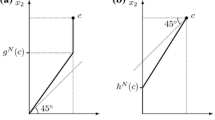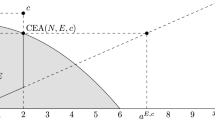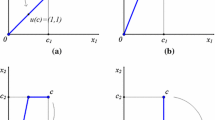Abstract
We investigate the implications of two protective properties, sustainability and exemption, for the resolution of conflicting claims. Under the properties, agents with sufficiently small claims in relation to the other claims and to the amount available are fully reimbursed. Our main results are three characterizations of the constrained equal awards rule. Namely, (1) it is the only rule satisfying sustainability and claims monotonicity, (2) it is the only rule satisfying sustainability and super-modularity, and (3) it is the only rule satisfying exemption, order preservation, and consistency.
Similar content being viewed by others
References
Aumann RJ, Maschler M (1985) Game theoretic analysis of a bankruptcy problem from the Talmud. J Econ Theory 36:195–213
Chun Y, Schummer J, Thomson W (2001) Constrained egalitarianism: a new solution to claims problems. Seoul J Econ 14:269–297
Dagan N (1996) New characterization of old bankruptcy rules. Soc Choice Welfare 13:51–59
Dagan N, Serrano R, Volij O (1997) A noncooperative view of consistent bankruptcy rules. Games Econ Behav 18:55–72
Herrero C, Villar A (2001) The three musketeers: four classical solutions to bankruptcy problems. Math Soc Sci 42:307–328
Herrero C, Villar A (2002) Sustainability in bankruptcy problems. TOP 10:261–273
Moulin H (2000) Priority rules and other asymmetric rationing methods. Econometrica 68:643–684
O’Neill B (1982) A problem of rights arbitration from the Talmud. Math Soc Sci 2:345–371
Thomson W (2000) Consistent allocation rules. University of Rochester, Rochester, Mimeo
Thomson W (2001) How to divide when there isn’t enough. Book manuscript, University of Rochester, Rochester
Thomson W (2003) Axiomatic analysis of bankruptcy and taxation problems: a survey. Math Soc Sci 45:249–297
Thomson W, Yeh C-H (2001) Minimal rights, maximal claims, and duality for division rules. University of Rochester, Rochester, Mimeo
Young P (1987) On dividing an amount according to individual claims or liabilities. Math Oper Res 12:398–414
Young P (1988) Distributive justice in taxation. J Econ Theory 43:321–335
Author information
Authors and Affiliations
Corresponding author
Rights and permissions
About this article
Cite this article
Yeh, CH. Protective Properties and the Constrained Equal Awards Rule for Claims Problems: A Note. Soc Choice Welfare 27, 221–230 (2006). https://doi.org/10.1007/s00355-006-0122-2
Received:
Accepted:
Published:
Issue Date:
DOI: https://doi.org/10.1007/s00355-006-0122-2




